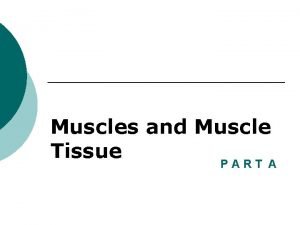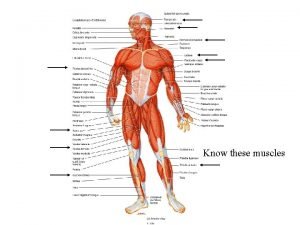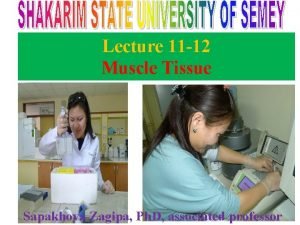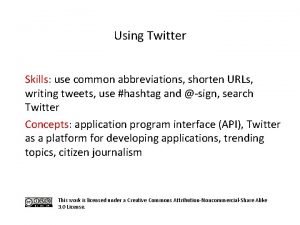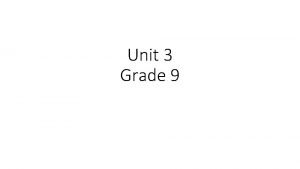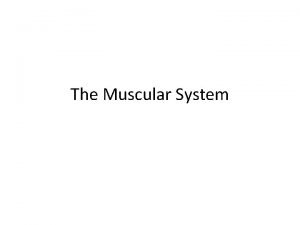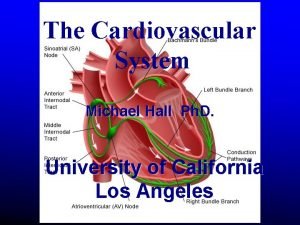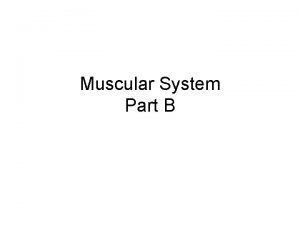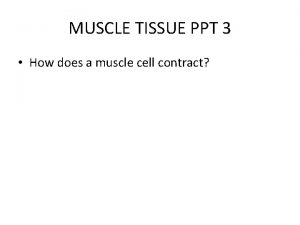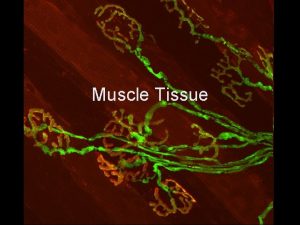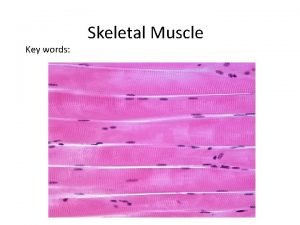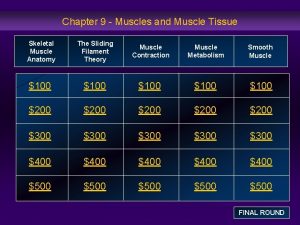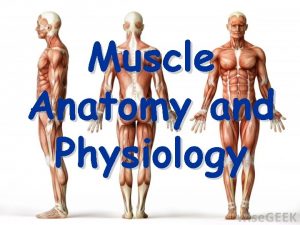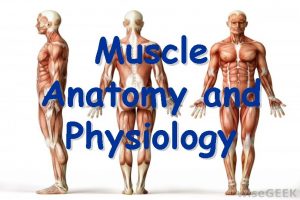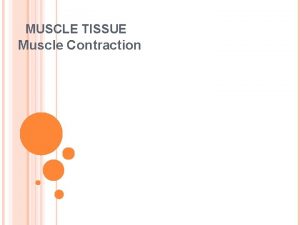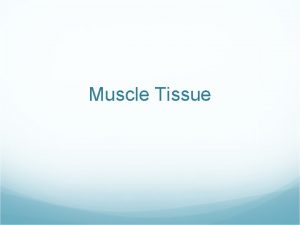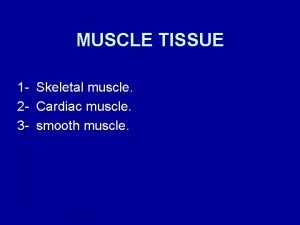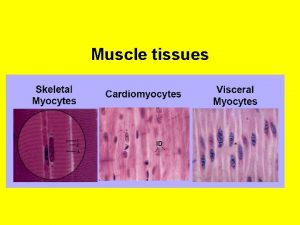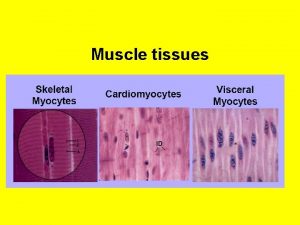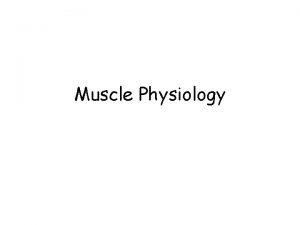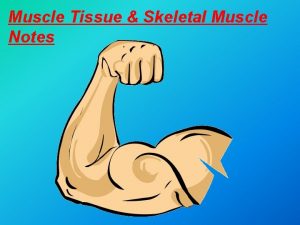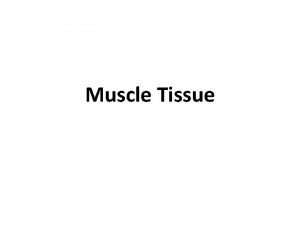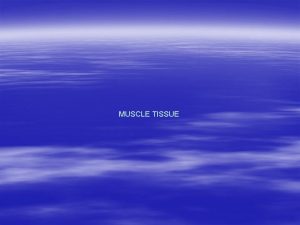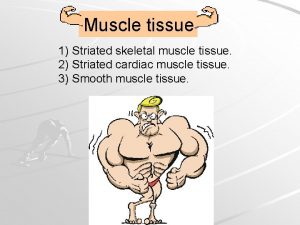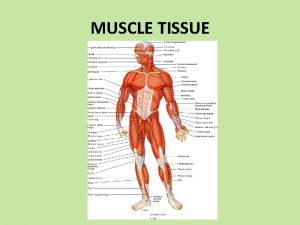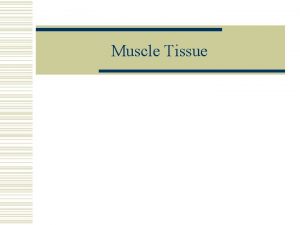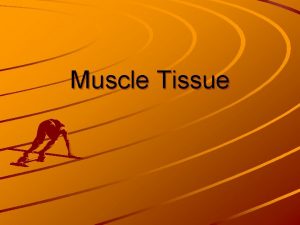Muscle Tissue Function is to contract or shorten



















- Slides: 19

Muscle Tissue • Function is to contract, or shorten, to produce movement • Three types: 1. Skeletal muscle 2. Cardiac muscle 3. Smooth muscle © 2015 Pearson Education, Inc.

Muscle and Nervous Tissue Pages 97 -101

Three types of muscle tissue • Skeletal • Cardiac • Smooth

Skeletal Muscle Tissue • Voluntarily (consciously) controlled • Attached to the bones or skin • Produces gross body movements or facial expressions • Characteristics of skeletal muscle cells – Striations (stripes) – Multinucleate (more than one nucleus) – Long, cylindrical shape © 2015 Pearson Education, Inc.

Figure 3. 20 a Type of muscle tissue and their common locations in the body. Nuclei Part of muscle fiber (a) Diagram: Skeletal muscle Photomicrograph: Skeletal muscle (195×)

Cardiac Muscle Tissue • • Involuntarily controlled Found only in the heart Pumps blood through blood vessels Characteristics of cardiac muscle cells – Striations – One nucleus, short, branching cells • Look somewhat like bamboo – Intercalated discs: • Areas between cells which contain gap junctions to connect cells together so that the impulse spreads across the heart to create one contraction at a time © 2015 Pearson Education, Inc.

Figure 3. 20 b Type of muscle tissue and their common locations in the body. Intercalated discs Nucleus (b) Diagram: Cardiac muscle Photomicrograph: Cardiac muscle (475×)

Compare the two- note the differences Skeletal Cardiac

Smooth Muscle Tissue • Involuntarily controlled • Found in walls of hollow organs such as stomach, uterus, and blood vessels – where constricting and enlarging is required – Peristalsis: a wavelike activity that moves digested material through the small intestine • Characteristics: – No visible striations – Single nucleus – Spindle-shaped cells © 2015 Pearson Education, Inc.

Figure 3. 20 c Type of muscle tissue and their common locations in the body. Smooth muscle cell Nuclei (c) Diagram: Smooth muscle Photomicrograph: Sheet of smooth muscle (285×)

Nervous Tissue • Two types of cells: – Neurons – nerve support cells called neuroglia • these insulate, protect, and support neurons • Function: receive and conduct electrochemical impulses to and from body parts – Irritability – Conductivity © 2015 Pearson Education, Inc.

Figure 3. 21 Nervous tissue. Brain Nuclei of supporting cells Spinal cord Nuclei of supporting cells Cell body of neuron Neuron processes Diagram: Nervous tissue Photomicrograph: Neurons (320×)

Figure 3. 22 Summary of the major functions and body locations of the four tissue types: epithelial, connective, muscle, and nervous tissues. Nervous tissue: Internal communication • Brain, spinal cord, and nerves Muscle tissue: Contracts to cause movement • Muscles attached to bones (skeletal) • Muscles of heart (cardiac) • Muscles of walls of hollow organs (smooth) Epithelial tissue: Forms boundaries between different environments, protects, secretes, absorbs, filters • Lining of GI tract organs and other hollow organs • Skin surface (epidermis) Connective tissue: Supports, protects, binds other tissues together • Bones • Tendons • Fat and other soft padding tissue

Tissue Repair (Wound Healing) • Occurs in two ways: 1. Regeneration • Replacement of destroyed tissue by the same kind of cells; cells divide to make new ones 2. Fibrosis • Repair by dense (fibrous) connective tissue (scar tissue) © 2015 Pearson Education, Inc.

Tissue Repair (Wound Healing) • The type of healing is determined by: 1. Type of tissue damaged 2. Severity of the injury © 2015 Pearson Education, Inc.

Events in Tissue Repair • Inflammation – Capillaries become very permeable – Clotting proteins migrate into the area from the bloodstream – A clot (visible fibers from blood) walls off the injured area • Granulation tissue forms – Growth of new capillaries – Phagocytes dispose of blood clot and fibroblasts – Rebuild collagen fibers © 2015 Pearson Education, Inc.

Events in Tissue Repair • Regeneration of surface epithelium – Scab detaches – Whether scar is visible or invisible depends on severity of wound • Scar tissue is constructed of many collagen fibers © 2015 Pearson Education, Inc.

Regeneration of Tissues • regenerate easily – Epithelial tissue (skin and mucous membranes) – Fibrous connective tissues and bone • regenerate poorly – Skeletal muscle – Dense connective tissues like tendons, ligaments • replaced largely with scar tissue – Cardiac muscle – Nervous tissue within the brain and spinal cord © 2015 Pearson Education, Inc.

Development Aspects of Cells and Tissues • Growth via cell division continues through puberty • Cell exposed to friction replace lost cells throughout life (like epithelial cells) • Connective tissue forms repair (scar) tissue – Scar tissue is a form of connective tissue constructed of many collagen fibers • Cells that lose ability to divide: (become amitotic) – muscle tissue (by the end of puberty) – Nervous tissue (shortly after birth) © 2015 Pearson Education, Inc.
 Is skeletal muscle an organ
Is skeletal muscle an organ Function of muscle tissue
Function of muscle tissue Muscle tissue function
Muscle tissue function Ifrs 15
Ifrs 15 Contingent contract and wagering agreement
Contingent contract and wagering agreement How to shorten title for running head
How to shorten title for running head How to shorten long quotes
How to shorten long quotes Twitter share abbr
Twitter share abbr Abridge synonym
Abridge synonym Relative adverb sentences
Relative adverb sentences Shorten synonym
Shorten synonym Desiree dunn
Desiree dunn Jaringan epitel dapat ditemukan di
Jaringan epitel dapat ditemukan di Muscle tissue
Muscle tissue Muscle tissue
Muscle tissue Smooth muscle gap junctions
Smooth muscle gap junctions Tropomyosin muscle contraction
Tropomyosin muscle contraction Classification of muscle tissue
Classification of muscle tissue Skeletal muscle
Skeletal muscle Muscles and muscle tissue chapter 9
Muscles and muscle tissue chapter 9
